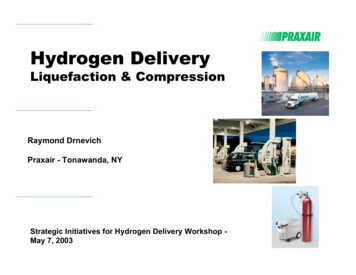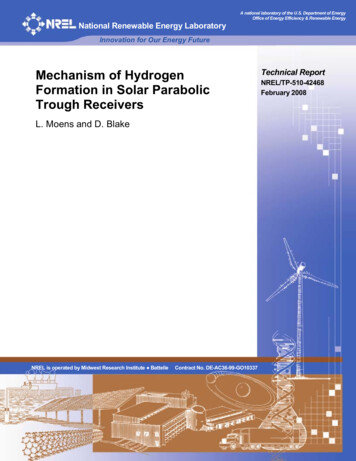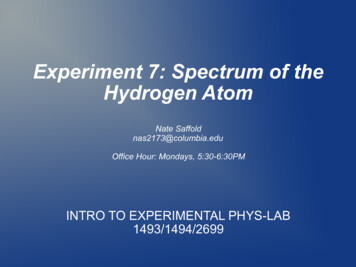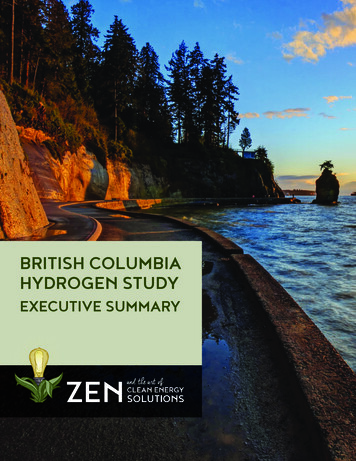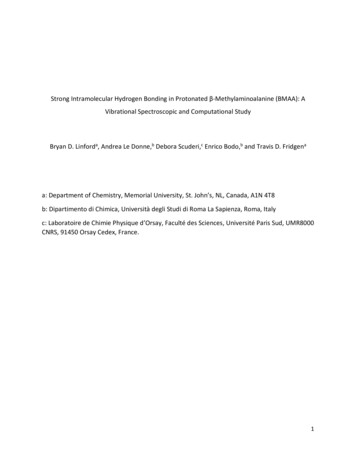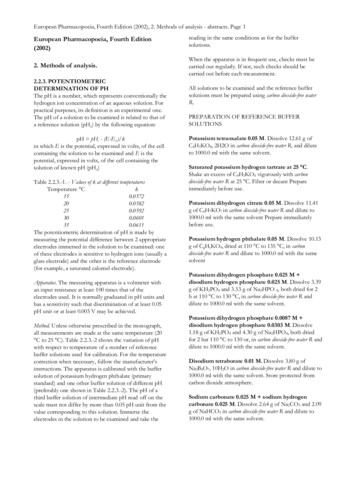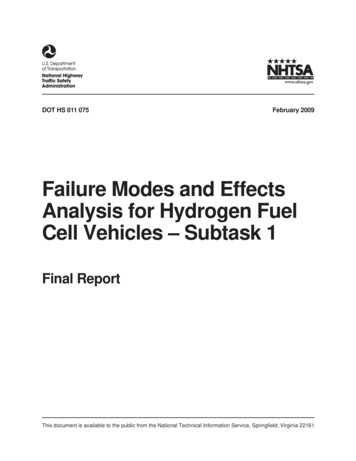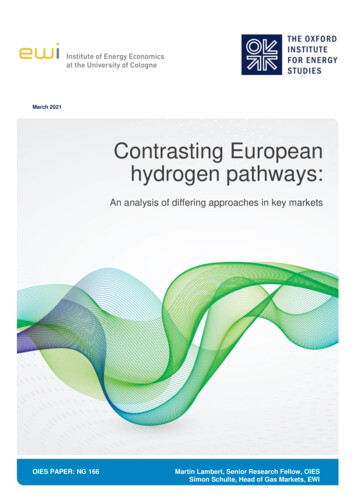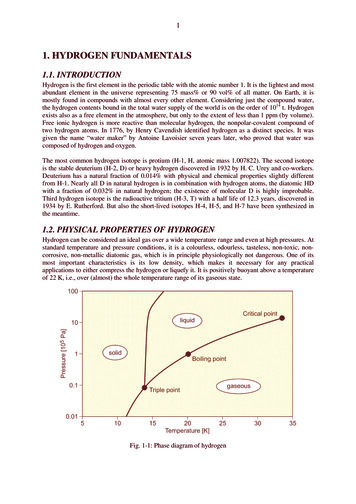
Transcription
11. HYDROGEN FUNDAMENTALS1.1. INTRODUCTIONHydrogen is the first element in the periodic table with the atomic number 1. It is the lightest and mostabundant element in the universe representing 75 mass% or 90 vol% of all matter. On Earth, it ismostly found in compounds with almost every other element. Considering just the compound water,the hydrogen contents bound in the total water supply of the world is on the order of 1014 t. Hydrogenexists also as a free element in the atmosphere, but only to the extent of less than 1 ppm (by volume).Free ionic hydrogen is more reactive than molecular hydrogen, the nonpolar-covalent compound oftwo hydrogen atoms. In 1776, by Henry Cavendish identified hydrogen as a distinct species. It wasgiven the name “water maker” by Antoine Lavoisier seven years later, who proved that water wascomposed of hydrogen and oxygen.The most common hydrogen isotope is protium (H-1, H, atomic mass 1.007822). The second isotopeis the stable deuterium (H-2, D) or heavy hydrogen discovered in 1932 by H. C. Urey and co-workers.Deuterium has a natural fraction of 0.014% with physical and chemical properties slightly differentfrom H-1. Nearly all D in natural hydrogen is in combination with hydrogen atoms, the diatomic HDwith a fraction of 0.032% in natural hydrogen; the existence of molecular D is highly improbable.Third hydrogen isotope is the radioactive tritium (H-3, T) with a half life of 12.3 years, discovered in1934 by E. Rutherford. But also the short-lived isotopes H-4, H-5, and H-7 have been synthesized inthe meantime.1.2. PHYSICAL PROPERTIES OF HYDROGENHydrogen can be considered an ideal gas over a wide temperature range and even at high pressures. Atstandard temperature and pressure conditions, it is a colourless, odourless, tasteless, non-toxic, noncorrosive, non-metallic diatomic gas, which is in principle physiologically not dangerous. One of itsmost important characteristics is its low density, which makes it necessary for any practicalapplications to either compress the hydrogen or liquefy it. It is positively buoyant above a temperatureof 22 K, i.e., over (almost) the whole temperature range of its gaseous state.Fig. 1-1: Phase diagram of hydrogen
2Hydrogen gas is highly diffusive and highly buoyant; it rapidly mixes with the ambient air uponrelease. The diffusion velocity is proportional to the diffusion coefficient and varies with temperatureaccording to Tn with n in the range of 1.72-1.8. Diffusion in multi-component mixtures is usuallydescribed by the Stefan-Maxwell equation. Corresponding diffusion rates of hydrogen in air are largerby about a factor of 4 compared to those of air in air. The rising velocity under the influence of(positively) buoyant forces cannot be determined directly, since they are dependent on the densitydifference between hydrogen and air as well as on drag and friction forces. Also shape and size of therising gas volume as well as atmospheric turbulence have an influence on the final velocity of therising gas. The positive buoyancy of hydrogen is a favourable safety effect in unconfined areas, but itcan cause a hazardous situation in (partially) confined spaces, where the hydrogen can accumulate,e.g., underneath a roof. Both diffusion and buoyancy determine the rate at which the gas mixes withthe ambient air. The rapid mixing of hydrogen with the air is a safety concern, since it leads very soonto flammable mixtures, which on the other hand – for the same reason – also will quickly dilute to thenon-flammable range. Therefore it is estimated that in a typical unconfined hydrogen explosion, only afraction of the gas mixture cloud is involved releasing in fact not more than a few per cent of thetheoretically available energy.Because of its small size, its small molecular weight and its low viscosity, hydrogen can cause aproblem with respect to the propensity of the gas to leak at a larger molecular flow rate than othergases. Diffusion in small amount is even possible through intact materials, in particular organicmaterials, which may lead to gas accumulation in confined spaces. This holds for the liquid state.Leakage rates are by a factor of 50 higher than for water and by a factor of 10 compared to nitrogen.The addition of an odorant or colorant would ease the detection of small leaks; however, this is notpracticable in most situations, and not feasible for LH2.Hydrogen gas dissolved in liquids will permeate into adjoining vessel materials. At elevatedtemperatures and pressures, hydrogen attacks mild steels severely, causing decarburization andembrittlement. This is a serious concern in any situation involving storage or transfer of hydrogen gasunder pressure. Proper material selection, e.g., special alloy steels, and technology is required toprevent embrittlement.Hydrogen coexists in two different forms, ortho and para hydrogen, whose partition is dependent onthe temperature. Normal hydrogen at room temperature is 75 % ortho (nuclear spins aligned) and 25 %para (spins anti-aligned). In the lower temperature range 80 K, para hydrogen is the more stableform. At 20 K, the thermal equilibrium concentrations are 99.821 % para and 0.179 % ortho. Thetransition takes place over a longer period (about 3 - 4 days), until a new equilibrium state is reached.However, magnetic impurities and also small oxygen concentrations are able to catalyze ortho-paraconversions raising the rate by several orders of magnitude (very good: Fe(OH)3) to the order of hours.Any concentration of either spin state can be created at any temperature through the action of catalysts.Most physical properties are differing only slightly between the two spin states. Most important is thelarge energy difference between the two varieties, which results in major differences for the specificheats and thermal conductivities. The presence of a radiation field results in the generation of freehydrogen atoms and ions, which also act as catalysts before recombining. The recombination on theother hand produces excess ortho hydrogen.Hydrogen also exhibits a positive Thompson-Joule effect at temperatures above 193 K, the inversiontemperature. It means that the temperature of the hydrogen gas increases upon depressurization, whichmay lead to ignition. For example, the temperature change is six degrees, if a sudden pressure dropfrom 20 MPa to ambient pressure takes place. The chance of a spontaneous ignition just by that effect,however, is small; an explosion is more likely to occur because of electrostatic charging of dustparticles during the depressurization or autoignition at high temperatures.Liquid hydrogen (LH2) has the advantage of extreme cleanliness and the more economic type ofstorage, however, on the expense of a significant energy consumption of about one third of its heat ofcombustion. Another drawback is the unavoidable loss by boil off which is typical to maintain the coldtemperature in the tank. The evaporation rate is even enhanced when ortho hydrogen is stored. The
3heat liberated during the ortho-para conversion at 20 K is huge with 670 kJ/kg compared to a figure of446 kJ/kg for the latent heat of vaporization at the same temperature. This represents a safety issuerequiring a design of the hydrogen loop which is able to remove the heat of conversion in a safemanner.For open LH2 pools, it needs to be considered that cold hydrogen gas is less volatile compared toambient gas and thus more prone to the formation of a flammable mixture with air. Furthermore LH2quickly contaminates itself due to condensation and solidification of air constituents, which canparticularly lead to oxygen-enriched zones to form shock-explosive mixtures. In confined areas, anadditional hazard is given by the fact that due to the volume increase by a factor of 845, when LH2 isheated up to ambient conditions, the local atmosphere may change drastically. In an enclosed space,final pressure may rise to 172 MPa, which certainly over pressurizes systems to bursting.A further temperature decrease below the boiling point eventually results in mixtures of liquid andsolid hydrogen or slush hydrogen, SLH2. Slush offers the advantages of a higher density and aprolongation of the storage time of the cryogen as the solid melts and absorbs heat. A safety risk isarising from the decreasing vapour pressure even below atmospheric pressure, which demandsprotection against air ingress into the system. In addition, the conversion of ortho to para hydrogenconnected with the release of the respective heat of conversion as the solid is form, needs to be takeninto account [Sonntag 1988]. The triple point finally is the temperature (13.8 K) and pressure (7.2kPa), at which all three phases can exist in equilibrium (see Fig. 1-1).If hydrogen (or any other fluid) is maintained above its critical temperature and pressure is applied, asingle phase “supercritical fluid” forms. It is gas-like in that it is compressible, it is liquid-like in that ithas a comparable density, and there is some transitory state in between characterized by strongstructural fluctuations causing the unusual behaviour of fluid properties near their critical point. It alsoexhibits higher flow rates as compared with liquids. There is a strong dependence of thethermophysical properties of cryogenic hydrogen on temperature and pressure in the supercriticalstate. They vary strongly especially in the near-critical region. Cp has a maximum at the then calledthe pseudo-critical temperature (“thermal spike phenomenon”). Supercritical hydrogen might undergoa turbulent-to-laminar transition due to the dependence of viscosity on temperature. Heat transfercoefficients are unpredictable in the transition regime, and are much lower in the laminar regime.Hydrogen at extreme, but accessible pressures (2-3*105 MPa) and temperatures ( 4400 K) will makea phase transition to (liquid) metallic hydrogen which may be superconducting at room temperature.This effect predicted in 1935 was eventually proven in a shock compression test in 1996. Metallichydrogen is accepted to exist in the interior of Saturn and Jupiter, but has no practical application onEarth so far.Hydrogen is both in the gaseous and liquid phase essentially an insulator. Only above some critical“breakdown” voltage, where ionization occurs, it becomes an electrical conductor.1.3. CHEMICAL PROPERTIES OF HYDROGENHydrogen reacts both with non-metals (high electronegativity1) and with metals (low electronegativity) to form either ionic or covalent hydrides (e.g. HCl, H2O). The electronegativity ofhydrogen is 2.20 (Pauling scale).Hydrogen is able to react chemically with most other elements. In connection with oxygen, hydrogenis highly flammable over a wide range of concentrations. As a fuel it represents a clean,environmentally benign energy source. The mass-related energy density of hydrogen is very high; 1 kgof hydrogen contains 132.5 MJ, which is approximately 2.5 times more energy than is contained in 1kg of natural gas. The energy content of hydrogen is given as either lower heating value (LHV) of 2421The electronegativity is a measure for the attraction of electrons to the nucleus and its difference to thepartner’s electronegativity defines the character of the bond: nonpolar-covalent (difference 0), polar-covalent,or ionic (difference high).
4kJ/mol or as higher heating value (HHV) of 286 kJ/mol. The difference of 15.6%, which is largecompared to other gases, is due to the heat liberated upon condensation of the water vapour (whichcould be captured in a turbine, but not in a fuel cell).A stoichiometric hydrogen-air mixture, where all fuel is consumed upon reaction, i.e., wheremaximum combustion energy is released, contains 29.5 vol% of hydrogen. The combustion product ofhydrogen is water vapour. It burns in a non-luminous, almost invisible pale blue, hot flame to watervapour liberating the chemically bound energy as heat (gross heat of combustion:). The flametemperature of a burning (premixed stoichiometric) hydrogen-air mixture is max. 2403 K.There is a wide flammability range of hydrogen (at room temperature) between 4 and 75 vol% ofconcentration in air and up to 95 vol% in oxygen. The lower flammability limit (LFL) as the minimumamount of fuel that supports combustion, is usually the “more important” limit, since it will be reachedfirst in a continuous leakage. The flammability range widens with higher temperatures. The influenceof the temperature is expressed in the modified Burgess-Wheeler equation for the LFL, which is forhydrogen (at ambient pressure) [Zabetakis 1967]:c LFL c LFL (300 K ) 3.14(T 300) 4.0 0.013 (T 300) [vol %] , H c(1-1)where Hc is the net heat of combustion and T given in [K].The respective equation for the upper flammability limit (UFL) is [Eichert 1992]:cUFL 74.0 0.026 (T 300) [vol %] .(1-2)valid for the temperature range 150-300 K. Measurements of upward flame propagation at highertemperatures [Gasse 1992] have shown a further increase of the UFL with initial temperature reaching87.6% at 673 K. There is still no experimental data available on the influence of moisture on theflammability limits. For the determination of LFL and UFL of mixtures of fuels, the Le Chatelier ruleis the most commonly applied method:y1 Σ i,LmLi(1-3)where yi are the volume fraction and Li the flammability limit of fuel i. Le Chatelier’s rule was foundto be in accurate agreement with experimental data for the system H2-CO, but shows deviations up to35% for the systems methane-propane or methane-ethane [Choudhuri, 2005]. The GEXCONhandbook states that “the formula does not work properly for H2”.The potential for an explosion of a flammable hydrogen-air mixture is very high. The auto-ignitiontemperature, which is the minimum temperature of a hot surface that can ignite a flammable mixture,is for hydrogen in the range of 800-1000 K depending on the experimental conditions. It is relativelyhigh, but can be lowered by catalytic surfaces. Hydrogen gas does not have a flash point as it isalready a gas at ambient conditions. It means that cryogenic hydrogen will flash at all temperaturesabove its boiling point of 20 K.The minimum ignition energy, i.e., the spark energy required to ignite the “most easily ignitablehydrogen concentration in air” (which is usually not the stoichiometric mixture), is with 0.02 mJ verylow, much lower than for hydrocarbon-air mixtures. A weak spark or the electrostatic discharge by aflow of pressurized H2 gas or by a person ( 10 mJ) would suffice for an ignition; this is, however, nodifferent from other burnable gases. The minimum ignition energy is further decreasing withincreasing temperature, pressure, or oxygen contents. The hot air jet ignition temperature is lowest for
5hydrogen compared to all hydrocarbons decreasing further with increasing jet diameter. It is alsodependent on jet velocity and mixture composition.The “maximum experimental safe gap” (MESG) is the maximum distance (between two flat plates)which still allows flame propagation through the gap; it is for hydrogen 0.08 mm. The “quenchinggap” in air is the distance (between two flat plates) at which ignition of a flammable mixture issuppressed. It corresponds to the smallest diameter of a tube through which a flame can propagate.Faster burning gases have smaller quenching gaps. Hydrogen has a quenching gap of 0.64 mm.Because of the high explosion pressures, the MESG is always smaller than the quenching gap.The burning velocity in a flammable gas mixture, different from the flame speed, is indicating thespeed with which a smooth plane combustion wave advances into a stationary flammable mixture andis a pertinent property of the gas depending on temperature, pressure, and concentration. The burningvelocity of hydrogen in air at stoichiometric ambient conditions is 2.55 m/s reaching a maximum of3.2 m/s at a concentration of 40.1%, which would even increase to 11.75 m/s in pure oxygen.Compared to other hydrocarbon fuel-air mixtures, it is highest for hydrogen because of its fastchemical kinetics and high diffusivity. The higher the burning velocity, the greater is the chance for atransition from deflagration to detonation (DDT). In contrast, the flame speed, which is related to afixed observer, is much greater than the burning velocity due to the expansion of the combustionproducts, instabilities, and turbulent deformation of the flame. The maximum possible speed of adeflagrative burning flame is given by the speed of sound in the combustion products gas mixture,which is 975 m/s for a stoichiometric H2-air mixture.Fig. 1-2: Burning velocities in hydrogen-air mixtures, from [Kroener 2002]The detonability range is usually given to be 18 - 59 vol% of hydrogen concentration, however, therange was found to be depending on the system size. In [Tieszen 1986], a detonation range of 13-70%of H2 is given for a 43 cm tube. In the Russian detonation test facility RUT, the largest of its kind, alower detonability limit of as low as 12.5 vol% has been observed. In pure oxygen, the detonationrange is extended to 15-90% [Zabetakis 1967]. The detonation velocity in air reaches values in therange of 2000 m/s; in pure oxygen, it is up to 3500 m/s.The size of the detonation cell is a measure of the reactivity; the smaller the cell, the more reactive isthe mixture (Fig. 1-3). It serves to some extent as an indicator for DDT and can be measuredexperimentally. A stoichiometric hydrogen-air mixture with a cell size of 15 mm is highly reactive,whereas a stoichiometric methane-air mixture with a cell size measured of approx. 330 mm is the leastsensitive of the common fuels. Cell sizes increase with increasing deviation from stoichiometry. It wasin the late 1970s, when the usefulness of measurements of the detonation cell size λ was wellacknowledged. First step was finding a correlation between cell size and critical tube diameter
6(d 13*λ). This empirical law was the basis to develop a simple surface energy model which allowsthe derivation of a critical initiation charge weight for various hydrocarbon-air mixtures in pretty goodagreement with experimental data.Fig. 1-3: Detonation cell sizeThe critical tube diameter is the minimum diameter required for a detonation wave to emerge from atube and become a detonation in an unconfined cloud. It is a measure of minimum dimensions of anunconfined detonable cloud. The detonation initiation energy given in mass of high explosive (TNT ortetryl) is the minimum energy necessary to initiate a spherical detonation wave; the energy content oftetryl corresponds to 4.3 MJ/kg.The distance in which the flame front at the ignition point develops to a detonation depends on manyparameters such as temperature, pressure, mixture composition, geometry (obstacles), and ignitionsource strength. For a stoichiometric hydrogen-air mixture to detonate, a typical figure of tube lengthover diameter ratio is approximately 100.It is known from the experience that a hydrogen-air gas cloud evolving from the inadvertent release ofhydrogen upon the failure of a storage tank or pipeline liberates only a small portion of its thermalenergy contents in case of an explosion, which is in the range of 0.1-10 %, in most cases 1 % [Lind1975].The explosion of a hydrogen-air mixture cloud results in the formation of a pressure wave, which isdifferent dependent on the combustion mode as is shown in Fig. 1-4. In the deflagration of a freehydrogen-air gas cloud, the maximum overpressure is in the order of 10 kPa. An overpressure of 7 kPais still deemed not dangerous; at 7 kPa, people would fall down to the ground; at 35 kPa, damage ofear drums is expected; 240 kPa is considered a threshold value above which fatalities must be takeninto account.
7Fig. 1-4: Pressure signals from different hydrogen combustion modes, from [Kuznetsov 2005]The thermal energy radiated from a flame corresponds to the higher heating value. It can be reduceddue to absorption by moisture in the atmosphere. The radiation emitted from a hydrogen flame is verylow due to a strong absorption by the ambient water vapour (emissivity 0.1) unlike hydrocarbonflames ( 1) [ADL 1960]. Therefore, despite its high flame temperature, the burning hazard iscomparatively small. The major problem is given in the non-visibility even in a dark room (unlessimpurities in the air are present), and therefore difficult to recognize and localize. An advantage ofhydrogen-air fires is the fact that there is no smoke generation (assuming no other material be ignited),which is important for confined areas.Main characteristic data of hydrogen are summarized in Table 1-1 taken, e.g., from [McCarty 1981],[Peschka 1984], [ISO 1991], and various other (internet) sources.
8Table 1-1: Physical and chemical parameters of hydrogenfrom [1] and other sourcesParameterMolecular weight [g/mol]Stoichiometric fraction in air [vol%]Boiling point (BP) [K]Melting point (MP) [K]Triple point: Temperature [K]Pressure [kPa]Critical point: Temperature [K]Pressure [MPa]Density [kg/m3]Electronegativity [Pauling scale]Density of gas @ NTP (2) [kg/m3]gas @ STP (1) [kg/m3]gas @ BP [kg/m3]liquid @ BP [kg/m3]solid @ 4 K [kg/m3]Expansion ratio liquid/ambientDiffusion coefficient @ NTP (2) [m2/s]Diffusion velocity @ NTP (2) [m/s]Buoyant velocity [m/s]Specific heat (constant p) of gas @ NTP (2) [kJ/(kg K)]gas @ STP (1) [kJ/(kg K)]gas @ BP [kJ/(kg K)]liquid @ BP [kJ/(kg K)]Thermal conductivity of gas @ NTP (2) [W/m K]gas @ BP [W/m K]liquid @ BP [W/m K]Viscosity of gas @ NTP (2) [ Poise]gas @ BP [ Poise]liquid @ BP [ Poise]Surface tension @ BP [N/m]Vapour pressure @ [Pa]Heat of conversion from para to ortho [kJ/kg]Heat of melting (fusion) @ MP [kJ/kg]Heat of vaporization @ BP [kJ/kg]Vaporization index (3) [K cm3/J]Vaporization rate of LH2 pool [mm/s]Heat of sublimation [kJ/kg]Speed of sound in gas @ NTP (2) [m/s]gas @ BP [m/s]liquid @ BP [m/s]in stoichiometric H2-air mixture [m/s]Inversion temperature [K]Flammability limits in air [vol%]Detonability limits in air [vol%]Minimum ignition energy [J]for detonationAuto-ignition temperature in air [K]Hot air jet ignition temperature [K]Gross heat of combustion or HHV [kJ/mol] @ 15 CNet heat of combustion or LHV [kJ/mol] @ 15 CFlame temperature 731.42.200.083450.089901.33870.7888.08450.61*10-4 0.021.2 - 132.01.93*10-3708.858.8445.68.94.2 - 8.3379.6129435510934041934.0 - 75.0 (4)13 - 70 (5)1.9*10-5 10,000793 – 1023 (858)943286.1241.72318
9Burning rate of LH2 pool [mm/s]Laminar burning velocity in air [m/s]Visible laminar flame speed [m/s]Deflagration pressure ratioQuenching distance @ NTP (2) [mm]Maximum experimental safe gap @ NTP (2) [mm]Adiabatic flame temperature [K]Detonation velocity [m/s]CJ velocity [m/s]CJ detonation pressure ratio pCJ/p0Energy release [MJ/kg mixture]Detonation cell size [mm]Critical tube diameter [m]Detonation initiation energy [g tetryl]Detonation induction distance @ NTP (2)TNT equivalent [g TNT/g](1)(2)(3)(4)(5)0.5 – 1.12.65 - 3.2518.68.150.640.0823181480 - 2150196815.62.82150.21.1Length/Diameter 10026.5STP (Standard temperature and pressure): 273 K, 101325 Pa.NTP (Normal temperature and pressure): 293 K, 101325 Pa.Indicates the relative ease of a substance to vaporize.LFL is valid for upward propagation of flame. For downward propagation, LFL values is 5.3 vol%.Valid for weak ignition. For a high-energy igniter, a range of 11.6 - 74.9 was quoted.1.4. ReferencesADL. Arthur D. Little Inc. Final Report on an Investigation of Hazards Associated with the Storageand Handling of Liquid Hydrogen. Report C-61092, Cambridge, USA (1960).Choudhuri A.R., Investigation on the Flame Extinction Limit of Fuel Blends. Combustion andPropulsion Research Laboratory at the University of Texas at El Paso, USA (2005).ISO. Basic Considerations for the Safety of Hydrogen Systems. Technical Report ISO/PDTR 15916(2001).Eichert H., et.al., Gefährdungspotential bei einem verstärkten Wasserstoffeinsatz, DeutscheForschungsanstalt fuer Luft- und Raumfahrt, Stuttgart, Germany (1992).Gasse A., Experimentelle Bestimmung und Simulation von Explosionsgrenzen, untersucht anwasserstoffhaltigen Brenngasgemischen. Dissertation, University of Paderborn, Shaker, Aachen,Germany (1992).Kroener M., Fritz J., Sattelmayer T., Flashback Limits for Combustion Induced Vortex Breakdown ina Swirl Burner. Proc. 47th ASME Int. Gas Turbine & Aeroengine Tech. Congress, Amsterdam, TheNetherlands, June 3-6, 2002.Kuznetsov M., et.al., Effect of Pressure and Temperature on Flame Acceleration and DDT Limits forMethane-Air Mixtures, Proc. European Combustion Meeting (ECM2005), April 3-6, 2005, Louvainla-Neuve, Belgium, Published by The Belgian Section of The Combustion Institute (Eds. V. Dias J.Vandooren), R24-208 (1-5), 2005.Lind C.D., What Causes Unconfined Vapor Cloud Explosions. Loss Prevention 9 (1975) 101-105.McCarty R.D., Hord J., Roder H.M., Selected Properties of Hydrogen (Engineering Design Data).National Bureau of Standards Monograph 168, US Government Printing Office, Washington (1981).Peschka W., Flüssiger Wasserstoff als Energieträger, Technologie und Anwendungen. Springer Verlag(1984).Sonntag R. et.al. Slush Hydrogen, Gelled Hydrogen, and Gelled-Slush Hydrogen. NASP ContractorReport 1027, NASA Langley Research Center (1988).Tieszen S.R., et.al., Detonation Cell Size Measurements in Hydrogen-Air-Steam Mixtures, Prog.Astronaut. Aeronaut., 106 (1986) 205-219.Zabetakis M.G., Safety with Cryogenic Fluids. Plenum Press New York, USA (1967).
the temperature. Normal hydrogen at room temperature is 75 % ortho (nuclear spins aligned) and 25 % para (spins anti-aligned). In the lower temperature range 80 K, para hydrogen is the more stable form. At 20
